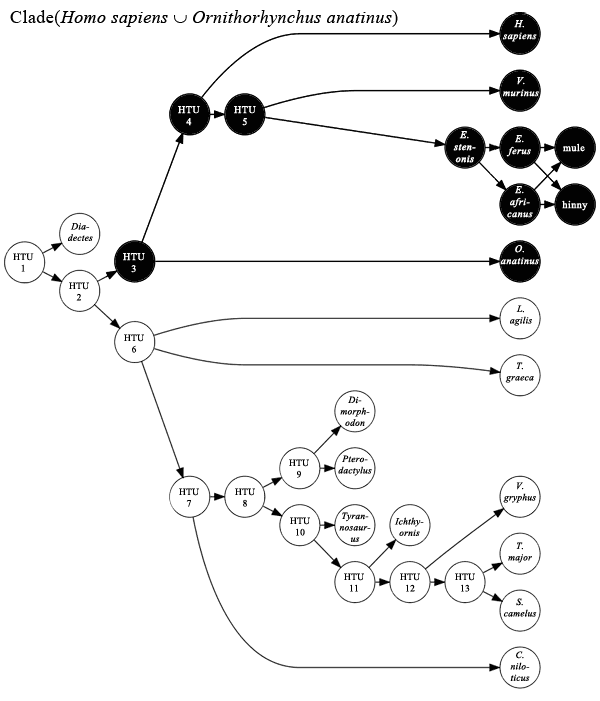Some examples of the updated notation, using humans (Homo sapiens), platypuses (Ornithorhynchus anatinus), and Dimetrodon grandis, a stem-mammal:
Union. Homo sapiens ∪ Ornithorhynchus anatinus = all humans and all platypuses (polyphyletic taxon, also monothetic)
Exclusive Predecessors. Homo sapiens ← Ornithorhynchus anatinus = humans and all of their ancestors, except for the ancestors shared with platypuses (lineage)
Synapomorphic Predecessors. "milk glands" @ Homo sapiens = humans and all human ancestors to possess milk glands synapomorphic with those in humans (lineage)
Node-Based Clade. Clade(Homo sapiens ∪ Ornithorhynchus anatinus) = Mammalia
Branch-Based Clade (simple). Clade(Homo sapiens ← Ornithorhynchus anatinus) = "Pan-Theria"
Branch-Based Clade (multiple external specifiers). Clade(Homo sapiens ← Ornithorhynchus anatinus ∪ Dimetrodon grandis) = "Pan-Theria"
Branch-Based Clade (multiple internal specifiers). Clade(Homo sapiens ∪ Ornithorhynchus anatinus ← Dimetrodon grandis) = (unnamed clade comprised mostly of Therapsida)
Null Branch-Based Definition (multiple internal specifiers). Clade(Homo sapiens ∪ Dimetrodon grandis ← Ornithorhynchus anatinus) = ∅
Apomorphy-Based Clade. Clade("milk glands" @ Homo sapiens) = "Apo-Mammalia"
Node-Modified Crown Clade. Crown(Homo sapiens ∪ Dimetrodon grandis, "extant as of or after 2010") = Mammalia
Branch-Modified Crown Clade. Crown(Homo sapiens ← Ornithorhynchus anatinus, "extant as of or after 2010") = Theria
Apomorphy-Modified Crown Clade. Crown("milk glands" @ Homo sapiens, "extant as of or after 2010") = Mammalia
Total Clade. Total(Mammalia, "extant as of or after 2010") = Synapsida (or "Pan-Mammalia")

Image showing a node-based clade (Mammalia) under a given phylogenetic hypothesis. Click to enlarge. More here.
Very nice!
ReplyDeleteI now feel that we have all been really dumb in not spotting long ago that this was the way to go :-)
Thanks! I'm not sure I would have thought of it had you not pointed out some issues with my thinking on the previous version.
ReplyDeleteIncidentally, this also suggests that we could call the definition styles union-, exclusion-, and synapomorphy-based instead of node-, branch-, and apomorphy-based. I'm not about to start doing that, though, because the existing terms are fine and pretty well-entrenched. (Not to mention that even the well-reasoned switch from "stem-based" to "branch-based" has had trouble getting a toehold.)